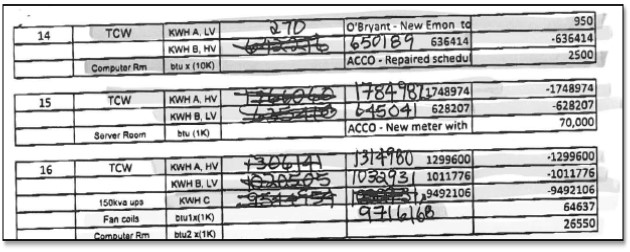Are These Common Submeter Billing Mistakes in Your Spreadsheet?
If you have submeters in your building, then you probably have a meter reading process that goes something like this: First, someone walks around with a clipboard, writing down submeter readings by hand. Next, that clipboard is handed to another member of the team, who inputs those readings into an inherited spreadsheet along with the monthly submeter billing information. Then, that spreadsheet spits out the amounts to charge each tenant. Finally, invoices are manually generated and sent to the tenants for payment.
Does this sound familiar?
We’ve seen hundreds of these spreadsheets, and handled every kind of billing scenario you can imagine. The one thing they all have in common? Mistakes. This is due to the manual nature of these processes and the complex submeter billing scenarios many buildings are handling. We regularly see scenarios where property management teams are under- or over-billing their tenants each month — sometimes by thousands of dollars.

Since this process often lacks an audit trail, property teams can be put in a difficult and costly situation if a tenant challenges the readings. We want to help you make sure you’re billing your tenants correctly for their supplemental meters, so we’ve put together a list of the most common mistakes we see.
- Misread or Mistyped Values
If your clipboard looks anything like the ones we’ve seen, it can be tough to decipher. Building engineers are often reading multiple meters, with very similar serial numbers, right next to each other, in dark or tight spaces. The figures on the clipboard could be incorrect, hard to read, and mistakes may not be noticed for weeks. At that point you can’t go back and read the meter again, so there’s no way to correct the mistake. Spreadsheet errors can have many repercussions as you try to make sense of confusing readings from previous months. - Incorrect Rollovers
Meters with a display of 4 or more digits can be a tricky to read. When the meter hits 9999, it rolls over to 10,000, but it will display on the meter as 0000. However, if you’re not aware of this, depending on the multiplier, it could lead to a significant under-billing of hundreds, or even thousands of dollars. - Incorrect Multipliers
Meter multipliers come in a variety of numerals. You can have multipliers of 2, 4, 8, 16, or even 12,000! You could also have billing multipliers. These multipliers might change when you replace a meter, but if no one remembers to update the spreadsheet you could be using an old multiplier on a new meter. This is, by far, one of the most expensive mistakes we’ve seen on spreadsheets, and can result in thousands of dollars of misbilling each month. - Incorrect Formulas
Billing spreadsheets involve a lot of formulas. You need to calculate the blended rate for your utilities and include a fair amount of logic to get to the correct billing amount for each tenant. That’s usually why complex spreadsheets are handed down from property team to property team. However, if you make one mistake when you’re updating a formula, it will have repercussions across the entire spreadsheet. It can be challenging to locate and fix mistakes after the change has been made, especially on a spreadsheet you inherited.
These mistakes are incredibly common for property teams and could be putting your team at risk if mistakes are discovered after years of incorrect billing.
Our team provides a much-needed second set of eyes for each of our Submeter Billing Service clients. Our software automates the billing, and then our own finance team checks to ensure the meters are being billed correctly.
We hope these tips encourage you to review your spreadsheet. If you’re still concerned that your spreadsheet could be hiding an error or two, our team will audit it for free as part of our assessment process. Simply fill out the demo request form below and we’ll contact you about next steps.



